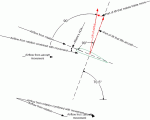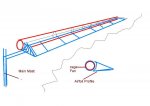how low can it go? interference of rotational vector at the hub/root
how low can it go? interference of rotational vector at the hub/root

hwell:
If the speed is way too low it won't autorotate?
Isn't it the angle of attack that takes foward vector of force into rotation? what about very very slow 16-40, max 60rrpm can't disk loading and coning become less of a tourque factor, but would require more blades, softer & self adjusting of the AoA reguardless of hub tilt?
A smart blade that gets control information from the hub (IR transeiver) and send back air flow data & presure? :flame:
Sorta a lot to mount on a few ultrsonically welded, CNC air knife cut pieces of Tyvek? at least if the electronics is distributed with more at the tip a weight for stability won't just be a dead weight.
O' to wish for a rich kite maker to show up at my door & the rotors would be near complete.
now
:focus:how low can rrpm be before near field fluid wake of previous blade in rotation interupt rotational forces. i've been looking at the vector drawing way too flat vectored?:noidea: does anyone have a rrpm counter to measure a maple seed pod? if blade shape is feathered on retreating blade vibration energies are ripest for collection to tuned load (
ooopps)?
Where are the all my nerdy math friends with the slide rules now:wacko:?
The software flow charts & coding is easy, making the DSP completely light enough and the leading edge and inflation controls mechanically sound NOW THAT's a good trick!!!:rapture:
Always have fun & smile at yourself a little each day





